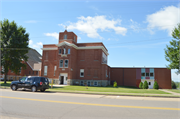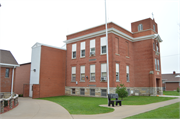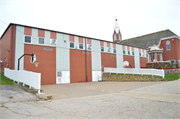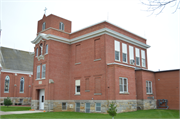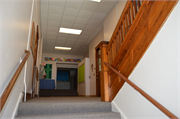Property Record
305 W MAIN ST
Architecture and History Inventory
| Historic Name: | Holy Ghost School |
|---|---|
| Other Name: | Holy Ghost School |
| Contributing: | Yes |
| Reference Number: | 55790 |
| Location (Address): | 305 W MAIN ST |
|---|---|
| County: | Grant |
| City: | Dickeyville |
| Township/Village: | |
| Unincorporated Community: | |
| Town: | |
| Range: | |
| Direction: | |
| Section: | |
| Quarter Section: | |
| Quarter/Quarter Section: |
| Year Built: | 1919 |
|---|---|
| Additions: | 1960 |
| Survey Date: | 19952016 |
| Historic Use: | elementary, middle, jr.high, or high |
| Architectural Style: | Neoclassical/Beaux Arts |
| Structural System: | Masonry |
| Wall Material: | Brick |
| Architect: | |
| Other Buildings On Site: | |
| Demolished?: | No |
| Demolished Date: |
| National/State Register Listing Name: | Not listed |
|---|---|
| National Register Listing Date: | |
| State Register Listing Date: |
| Additional Information: | A 'site file' titled 'Holy Ghost Parish Historic District' exists for this property. It contains additional information such as correspondence, newspaper clippings, or historical information. It is a public record and may be viewed in person at the Wisconsin Historical Society, State Historic Preservation Office. 1995- "Holy Ghost Park is more well-known as the Dickeyville Grotto sculpture park. The complex is on the south side of West Main Street. Starting from the east along Main street, the first part of the complex is the gates to Holy Ghost Park. Then comes the rectory garage, then the rectory [55791], then an open space that is part of the sculpture park, then the grotto [both 44363], then the church [55789] and then the schoolhouse [55790]. The sculpture park extends southward behind the rectory and the grotto. Behind the church and the school is a large cemetery. Since this is a site with several resources, each will be discussed separately. School: Red brick, built in 1919 (datestone), two-story, flat-roofed school house with rusticated limestone basement story trimmed with a dressed stone beltcourse at the top. The stone basement story is pierced with double-hung windows on each side. Tall windows on the first and second stories have molded brick flat arches and stone sills. The original sash has been removed and replaced with double-hung units in the bottom half of the opening and a plain spandrel panel above. To the right on the front facade the windows have been filled in with brick. Placed off-center on the front facade is a large square entrance tower. A set of two doors of modern vintage are set back within the entrance opening, which is also trimmed with a flat arch of molded brick. Double windows on the second floor retain sash of the original size. A decorative grouping on the third floor of the tower consists of round-topped one-over-one windows to each side of a round-arched niche featuring a full-size statue of an angel and child. The niche is supported by corbeled stone sill and is crowned by a triangular parapet. Above these windows and the second story windows of the whole schoolhouse is a wide metal or wood cornice, which rises in a shallow pediment above the niche. A brick parapet above is trimmed by small brick dentils and a stone coping. Above this level, the tower rises another story and is pierced by three arches on each side. A decorative parapet, with a central Flemish gable, corner crenellations, a row of denticulated bricks and a thin stone coping, finish off the top of the tower. A large modern addition sits to the rear and below the old schoolhouse. The interior was not inspected. Holy Ghost Church began as a small mission church attached to a Catholic church in nearby Kieler. It was established in 1873, the same year that Dickeyville is said to have begun. In 1873-1874 a small frame church building was erected that was described in The Catholic Church in Wisconsin as "plain in exterior" but with a nice painting of the Holy Ghost descending on Mary that was dedicated in 1893. In 1895 the congregation included 48 families of a total of 53 families who lived in Dickeyville. The large brick church was built in 1913. According to an 1895 map of Dickeyville, a schoolhouse was in use by the late 19th century. The current school building dates to 1919. The Holy Ghost sculpture park is the highlight of this complex. The park was the creation of the pastor of the church, Father Matthias Wernerus. Wernerus was born in 1873 and served as pastor of Holy Ghost Church from 1918 until his death in 1931. He began his grotto in 1925 and worked diligently on it until 1930. Rev. Wernerus' cousin and housekeeper, a Miss Wernerus, assisted in the effort. Although they were both elderly at the time, they "toiled early and late for nearly five years mixing Portland cement and lifting rocks that would tax a man's strength" (Gregory, p. 567). Gregory further describes their effort: "The work was begun on a small scale, but took on increased proportions while it proceeded. As word traveled that such an edifice was to be, donations began to pour in. Stones came from every land inhabited by man, and the work went on. One central shrine is built at the east of the church proper, which is twenty-five feet high, about twenty feet wide and thirty feet long. The American flag is on one side and the Papal flag on the other, a "tree of faith," depicting "the seven gifts of faith," is shown in the rock. statues of the twelve apostles adorn a walk. Fences around the cemetery are covered with stone and colored glass flowers. Gregory concludes by describing a dispute that was taking place in 1932 over the $9000 in donations that were given to the grotto each year. Rev. Wernerus intended it to go to the congregation, but the Bishop became interested in the funds. How the dispute was resolved awaits further research." The church complex would be historically and architecturally significant even if the grotto did not exist. The church is an excellent example of turn-of-the-century church architecture and retains a great deal of its historic integrity. The rectory and schoolhouse contribute to the historic setting of the complex. The grotto and sculpture park, however, are superb examples of the grotesque style of folk sculpture that was associated often with Catholicism but is not common due to the great deal of work required to create it. The Dickeyville grotto is one of the finest examples of this type of folk sculpture remaining in the state, other examples of which include the Holy Family Grotto at the Villa St. Joseph in the Town of Washington, La Crosse County, the St. Phillips Grotto in Rudolph in Wood County and the Paul Wegner grotto in rural Sparta." -"USH 151, Dickeyville to Belmont", WisDOT# 1209-02-00, Prepared by Katherine Hundt Rankin (Preservation Consultant) for Rust Environment & Infrastructure Inc, 1995. 2016- "The district is comprised of approximately 5.3 acres, encompassing two tax parcels with multiple contributing and non-contributing resources. The Parish property currently contains the church [AHI#55789], school [55790], rectory [55791], cemetery [232926], and several utilitarian buildings. These buildings in the district represent the second generation of Parish buildings, built to accommodate a growing congregation after the first church, school, and rectory became too small or outdated. They are generally unified in appearance, despite their construction dates spanning approximately 20 years, by their red brick walls atop limestone foundations. In addition, the current Parish property contains the scattered elements of the Holy Ghost Park [44363], a series of shrines and grottos designed and constructed by Father Mathias Wernerus during his tenure as parish priest. The second tax parcel of the district contains the former convent [232925] for the teaching sisters of the school. Contributing buildings/sites The Holy Ghost Elementary School is a Vernacular, red brick building constructed in 1919. It replaced the second one-room school that had been constructed for Parish use. The main block is two stories tall with a limestone block foundation and an off-center entryway tower extending an additional story above the flat roof. An addition to the west and south was completed in 1960, consisting of a gymnasium, cafeteria space, and more classrooms. The main entryway, located in the tower, faces north and contains modern double doors underneath a flat brick lintel, with the building datestone and a pair of 1-over-1 windows above. The most notable decorative element is located on the third level of the tower: a round-arched niche containing a statue of an angel and child. Flanking the niche are two single-paned round arched windows. Above the niche is a pedimented cornice that also wraps around the entire building above the second story and below the flat parapet. The highest level of the tower has been completely reconstructed since the previous survey in 1995. Once an enclosed belfry with a central Flemish gable and three louvered arches on each side, the tower is now a three-sided parapet with blind windows mimicking the tracery found on the church windows. Windows throughout the rest of the school are replacements, and in almost every instance have been partially covered with spandrel panels, or completely in-filled with brick. However, the openings are still distinguishable from the surrounding wall surfaces due to the slight inset of the filler brick in the opening and the retention of the sills and lintels, suggesting that the window alterations are reversible. While the integrity of the school has seen the greatest reduction of all the buildings on the property, the relationship of the school with the other buildings of the complex has been maintained, and it can still be identified as a school from the exterior." -"Holy Ghost Parish Historic District", WISDot#1650-07-02, Prepared by UWM-CRM, (2016). |
|---|---|
| Bibliographic References: |
| Wisconsin Architecture and History Inventory, State Historic Preservation Office, Wisconsin Historical Society, Madison, Wisconsin |

